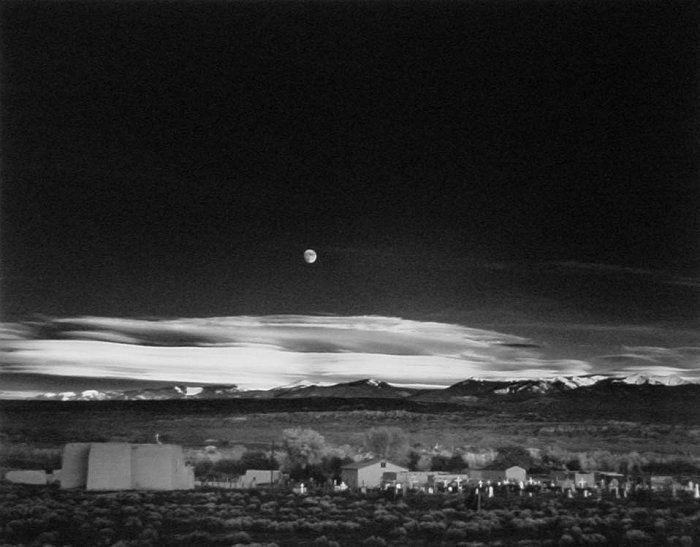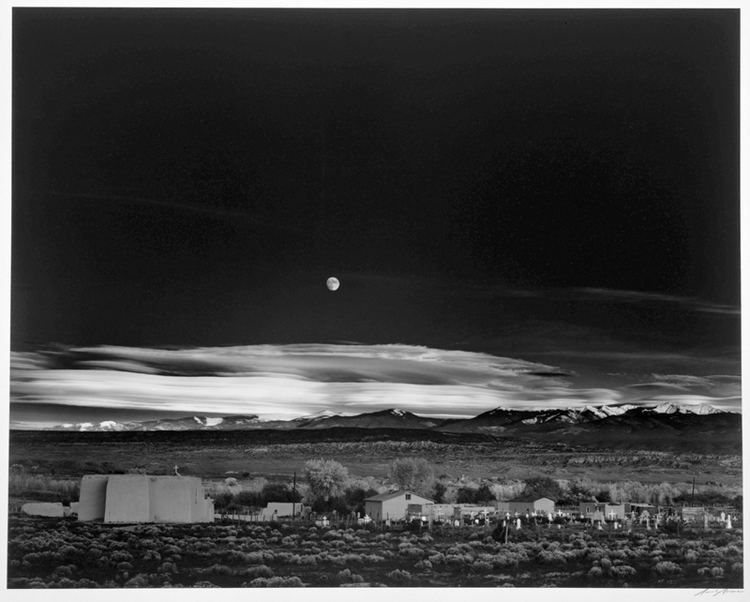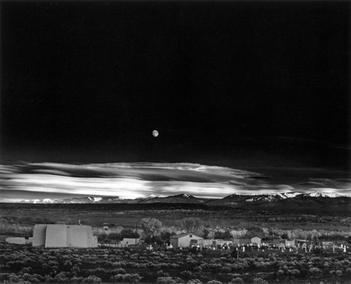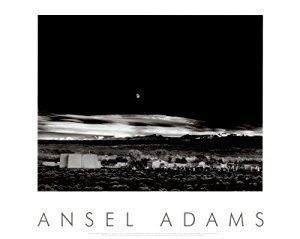Genre Landscape painting | ||
 | ||
Similar Ansel Adams artwork, Landscape paintings, Photography | ||
The story behind ansel adams s moonrise hernandez new mexico
Moonrise, Hernandez, New Mexico is a black and white photograph taken by Ansel Adams, late in the afternoon on November 1, 1941, from a shoulder of U.S. Route 84-285. The photograph became so popular and collectible that Adams personally made over 1,300 photographic prints of it during his long career.
Contents

On October 17, 2006, Sotheby's auctioned a print of this photograph for $609,600. Art historian H. W. Janson called this photo "a perfect marriage of straight and pure photography".

The approximate location where the image was taken is 36.057186°N 106.116974°W / 36.057186; -106.116974.
The making of Moonrise

The making of Moonrise has attracted unusually strong interest. In 1941, Secretary of the Interior Harold Ickes hired Adams for six months to create photographs of lands under the jurisdiction of the Department of the Interior. Adams was accompanied by his young son Michael and his best friend Cedric Wright on a long road trip around the west. They came upon the scene while traveling through the Chama River valley toward Española in late afternoon on November 1; accounts of what transpired differ considerably.
The image appeared in U.S. Camera Annual 1943, and Adams gave this account:

Later accounts were more dramatic. According to Mary Alinder, they encountered a "fantastic scene", a church and cemetery near Hernandez, New Mexico, and pulled to the side of the road. Adams recalled that he yelled at his son Michael and at Wright to "Get this! Get that, for God's sake! We don't have much time!" Desperate to capture the image in the fading light, they scrambled to set up the tripod and camera, knowing that only moments remained before the light was gone.
Adams gave a similar account in Examples
I could not find my Weston exposure meter! The situation was desperate: the low sun was trailing the edge of clouds in the west, and shadow would soon dim the white crosses ... I suddenly realized that I knew the luminance of the Moon — 250 cd/ft2. Using the Exposure Formula, I placed this value on Zone VII ... Realizing as I released the shutter that I had an unusual photograph which deserved a duplicate negative, I quickly reversed the film holder, but as I pulled the darkslide, the sunlight passed from the white crosses; I was a few seconds too late! The lone negative suddenly became precious.Moonrise had been variously listed as made in 1940, 1941, 1942, and 1944; attempts were made to determine the date, using astronomical calculations based on the Moon's position in the image. David Elmore of the High Altitude Observatory in Boulder, Colorado, concluded that Moonrise was taken on October 31, 1941, at 4:03 p.m. Elmore knew the picture was taken during the fall of 1941 through 1944; he found 36 plausible dates, and the October 31, 1941 date fit the best. Adams used this date in several publications, including Examples, though the time was given as 4:05 p.m. rather than 4:03 p.m. Dennis di Cicco of Sky & Telescope magazine noticed that the Moon's position at the time which Elmore had determined did not match the Moon's position in the image. Di Cicco "concluded that Adams had been at the edge of an old roadbed, about 50 feet west of the spot on the modern highway that Elmore had identified." After an independent analysis, he determined the time to be 4:49:20 p.m. on November 1, 1941. He reviewed his results with Elmore, who agreed with his conclusions. Elmore had made a couple mistakes; there were some distortion issues with his monitor, and he had the wrong coordinates for Hernandez, New Mexico.
